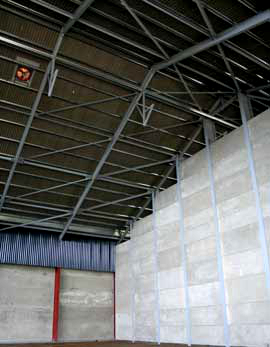The following article regarding the new grainstore at Scotland Farm appeared in Farmers Weekly on 31st May.
A new grainstore due to be finished as the Cereals Event takes place uses construction techniques designed to make maximum use of available space.
Come the end of harvest 2012, the new store being completed for PX Farms at DryDrayton, Cambridgeshire, will be packed with at least 21,000t of grain and rapeseed.
It’s been designed and specified as a futures store, to provide secure crop storage for the next 25 years at least, while making the most of available floor space to minimise storage cost.
“We’d taken on another contract farm, taking us to more than 5,000 acres, and wanted extra capacity for this and to service Wellgrain storage requirements,” says James Peck. “Also, we’re keen to continue expanding our contracting farming enterprise and wanted to plan for future capacity needs.”
Bins would have been useful for storing grain in parcels, he acknowledges: “But I like the flexibility – both now and in the future – of a big shed,” says Mr Peck.
Besides, as George O’Connell of engineers Tripp Batt & Co points out, the large building can be filled using minimal grain-handling machinery. Silos would require more equipment and consume more power.

The store
The store Mr O’Connell configured to meet PX Farms requirements is divided into three equal-size bays – two for wheat and one with closer-spaced ventilation inlets, making it suitable forrapeseed.
Each bay will hold at least 7,000t of grain within the building’s 91.7m-long, 32.6m-wide storage footprint. Getting in that much grain requires a seriously deep pile.
“When it’s full, the contents certainly will be piled high,” confirms Mr O’Connell. “We’re using 6.9m-high Milbury concrete retaining walls along the sides and then they’re stacked almost to the roof in the end walls and internal divisions so that a conveyor can fill the store to a fully surcharged depth of 13.4m from end to end.”
The new structure, which is built alongside and connected to the adjoining store, is not the usual portal design, but a braced box with a complex array of roof restraints and tubular diagonal bracing to withstand the big loadings involved.
Heavier-than-usual steel connecting plates and bolts are used and the retaining walls use panels up to 200mm thick.
John Allinson from Simpson & Allinson, which is building the store, reels off some more statistics: “The concrete panels weigh 750t in total and the building uses 250t of steel,” he says.
“The longest single piece is 16m – it’s almost a metre wide and weighs 4t – and there are 6,500m of purlins and side rails,” Mr Allinsonadds. “Just over 10,000 bolts hold it all together!”
The massive loading created by the storage depth was a major design issue, especially on the end walls and also on internal walls when one bay is full and the other empty.
“To channel those loadings back to ground level, we had to get the connections right between the roof bracings, pillars and diagonal bracing tubes between the pillars,” Mr Allinson points out.
The new store can be fed from the adjoining drying facility or via a new 120t/hr Cimbria intake conveyor and elevator installation housed within an end lean-to that also keeps the fuel supply for the continuous flow drier out of sight. A second wet bin – of 180tcapacity from the Bentall Rowlands range – has been added for more intake flexibility.
Outloading
For outloading, each of the three bays has a large doorway at the side, with retaining panels holding back the grain. Lifting out these big steel structures using the quick-attach couplings and a telescopic handler allows grain to cascade into a tall, covered out-loading bay at each doorway.
These bays stand proud of a side lean-to extension, housing Fläkt Woods crop ventilation fans that supply air across the floor through circular perforated plastic pipe, graduated in 750mm,600mm and 450mm diameters to provide even airflow through the crop.
“I’d normally use steel tubing, but it would probably be crushed beneath this much grain,” says George O’Connell. “The air tubes will be laid on the floor and restrained against the flow of grain, which should prevent them shifting, while still being quick and easy to remove as the store is emptied.”

Energy efficiency
The fans are operated using an extension to the existing Robydome temperature monitoring and control system, while the Kentracontinuous flow dryer is the first to be equipped with the Z-Tech microwave probe moisture measurement system. Designed to regulate the drying process more accurately, Mr Peck predicts the improvement in drying efficiency and control could save £40,000 in the first year alone.
Running cost savings also come from an array of sun-searching solar panels that provide up to 97% of energy requirements and by harvesting rain-water from a section of the vast roof that will provide more than enough for the farm’s crop-spraying requirements.
The original article can be viewed online by clicking here.
